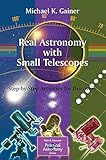Real Astronomy with Small Telescopes : Step-by-Step Activities for Discovery / edited by Michael K. Gainer.
Tipo de material: TextoSeries Patrick Moore’s Practical Astronomy SeriesEditor: London : Springer London, 2007Descripción: xvI, 148 páginas 90 ilustraciones recurso en líneaTipo de contenido:
TextoSeries Patrick Moore’s Practical Astronomy SeriesEditor: London : Springer London, 2007Descripción: xvI, 148 páginas 90 ilustraciones recurso en líneaTipo de contenido: - texto
- computadora
- recurso en línea
- 9781846285080
- QB1-991
Springer eBooks
The Celestial Sphere -- The Measurement of Time -- The Equatorial Telescope Mount -- Telescope Considerations -- Astronomical Photography -- The Sun -- The Moon -- The Planets -- Comets and Asteroids -- Visual Binary Stars -- A Binary Star True Orbit Projector -- Visual Observations of Variable Stars -- Photography of Variable Stars -- Star Clusters and Nebulae -- A Color–Magnitude Diagram for The Pleiades -- The Design of an Objective Prism Spectrograph -- The Proper Motion of Barnard’s Star.
It’s often said that astronomy is one of the very few sciences in which amateurs can make a contribution to real science. Even modest telescopes such as a small – 3-inch (80mm) – astronomical refractor or Maksutov can provide scientifically useful data. This is certainly true, but where to start? Real Astronomy with Small Telescopes tells you everything you’ll need to know about how to get started on "real" astronomy using a small telescope (and ideally a digital camera), and make a real contribution to our scientific knowledge. This book is the necessary introduction to real astronomy – derived from the author’s many years of experience in teaching the subject – that can be your starting point for serious work. Here, the emphasis is on what you can do with a small telescope, rather than just on what you can see through it. Finally, owners of big telescopes shouldn’t be put off – everything in this book applies equally (maybe more equally!) to larger instruments.
Para consulta fuera de la UANL se requiere clave de acceso remoto.


